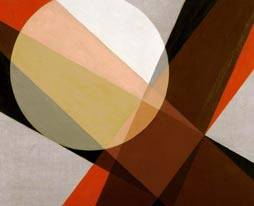Albers and Moholy-Nagy
From the Bauhaus to the New World
09 Mar - 04 Jun 2006

László Moholy-Nagy, 1927 (detail)
Collection Hattula Moholy-Nagy
© Hattula Moholy-Nagy / DACS courtesy Annely Juda Fine Art, London
Collection Hattula Moholy-Nagy
© Hattula Moholy-Nagy / DACS courtesy Annely Juda Fine Art, London
This thought-provoking and visually stunning exhibition is a long overdue opportunity to rediscover two pioneers of Modernism: German-born Josef Albers (1888-1976) and Hungarian-born László Moholy-Nagy (1895-1946).
Though their careers overlapped for barely five years, when both taught at the Bauhaus, their creative visions shared a number of concerns. These include an emphasis on experimentation, the subversion of traditional boundaries between high and applied art and a Utopian belief in art as a force for positive social change.
Spanning four decades, the exhibition takes as its starting point the early 1920s, when Albers and Moholy independently developed a rigorously abstract language. Of particular focus is the creative explosion of the Bauhaus years, when both artists moved freely between medias and disciplines. It follows their separate paths through to their emigration to the US in the 1930s, where both men continued to tirelessly push the conventions of artistic practise. As highly influential teachers, Albers and Moholy became important catalysts for the transition of Modernist ideas from Europe to the 'New World'.
With more than 200 works in a variety of media ranging from painting and moving sculptures to photography, film, furniture and graphic design, this will be the first Tate exhibition dedicated to early Modernist abstraction for more than two decades.
Though their careers overlapped for barely five years, when both taught at the Bauhaus, their creative visions shared a number of concerns. These include an emphasis on experimentation, the subversion of traditional boundaries between high and applied art and a Utopian belief in art as a force for positive social change.
Spanning four decades, the exhibition takes as its starting point the early 1920s, when Albers and Moholy independently developed a rigorously abstract language. Of particular focus is the creative explosion of the Bauhaus years, when both artists moved freely between medias and disciplines. It follows their separate paths through to their emigration to the US in the 1930s, where both men continued to tirelessly push the conventions of artistic practise. As highly influential teachers, Albers and Moholy became important catalysts for the transition of Modernist ideas from Europe to the 'New World'.
With more than 200 works in a variety of media ranging from painting and moving sculptures to photography, film, furniture and graphic design, this will be the first Tate exhibition dedicated to early Modernist abstraction for more than two decades.
